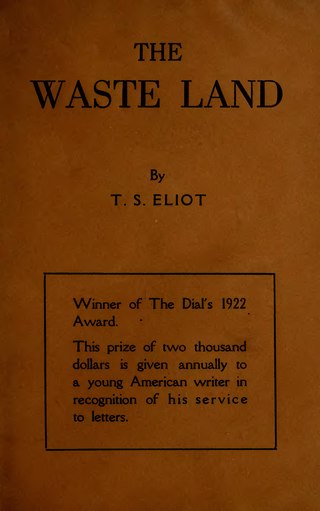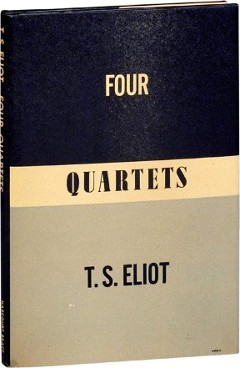Related Research Articles

Thomas Stearns Eliot was a poet, essayist, publisher, playwright, literary critic and editor. Considered one of the 20th century's major poets, he is a central figure in English-language Modernist poetry. Through his trials in language, writing style, and verse structure, he reinvigorated English poetry. He also dismantled outdated beliefs and established new ones through a collection of critical essays.
John Webster was an English Jacobean dramatist best known for his tragedies The White Devil and The Duchess of Malfi, which are often seen as masterpieces of the early 17th-century English stage. His life and career overlapped with Shakespeare's.
"To His Coy Mistress" is a metaphysical poem written by the English author and politician Andrew Marvell (1621–1678) either during or just before the English Interregnum (1649–60). It was published posthumously in 1681.

"The Love Song of J. Alfred Prufrock", commonly known as "Prufrock", is the first professionally published poem by American-born British poet T. S. Eliot (1888–1965). The poem relates the varying thoughts of its title character in a kind of stream of consciousness. Eliot began writing "Prufrock" in February 1910, and it was first published in the June 1915 issue of Poetry: A Magazine of Verse at the instigation of Ezra Pound (1885–1972). It was later printed as part of a twelve-poem pamphlet titled Prufrock and Other Observations in 1917. At the time of its publication, Prufrock was considered outlandish, but is now seen as heralding a paradigmatic cultural shift from late 19th-century Romantic verse and Georgian lyrics to Modernism.
Terza rima is a rhyming verse form, in which the poem, or each poem-section, consists of tercets with an interlocking three-line rhyme scheme: The last word of the second line in one tercet provides the rhyme for the first and third lines in the tercet that follows. The poem or poem-section may have any number of lines, but it ends with either a single line or a couplet, which repeats the rhyme of the middle line of the previous tercet.

"Ode on a Grecian Urn" is a poem written by the English Romantic poet John Keats in May 1819, first published anonymously in Annals of the Fine Arts for 1819.
"Gerontion" is a poem by T. S. Eliot that was first published in 1920 in Ara Vos Prec and Poems. The title is Greek for "little old man," and the poem is an interior monologue relating the opinions and impressions of an elderly man, which describes Europe after World War I through the eyes of a man who has lived most of his life in the 19th century. Two years after it was published, Eliot considered including the poem as a preface to The Waste Land, but was talked out of this by Ezra Pound. Along with "The Love Song of J. Alfred Prufrock" and The Waste Land, and other works published by Eliot in the early part of his career, '"Gerontion" discusses themes of religion, sexuality, and other general topics of modernist poetry.

"The Tyger" is a poem by the English poet William Blake, published in 1794 as part of his Songs of Experience collection and rising to prominence in the romantic period. The poem is one of the most anthologised in the English literary canon, and has been the subject of both literary criticism and many adaptations, including various musical versions. The poem explores and questions Christian religious paradigms prevalent in late 18th century and early 19th century England, discussing God's intention and motivation for creating both the tiger and the Lamb.

"The Hollow Men" (1925) is a poem by the modernist writer T. S. Eliot. Like much of his work, its themes are overlapping and fragmentary, concerned with post–World War I Europe under the Treaty of Versailles, hopelessness, religious conversion, redemption and, some critics argue, his failing marriage with Vivienne Haigh-Wood Eliot. It was published two years before Eliot converted to Anglicanism.

"A Poison Tree" is a poem written by William Blake, published in 1794 as part of his Songs of Experience collection. It describes the narrator's repressed feelings of anger towards an individual, emotions which eventually lead to murder. The poem explores themes of indignation, revenge, and more generally the fallen state of mankind.

"Ode: Intimations of Immortality from Recollections of Early Childhood" is a poem by William Wordsworth, completed in 1804 and published in Poems, in Two Volumes (1807). The poem was completed in two parts, with the first four stanzas written among a series of poems composed in 1802 about childhood. The first part of the poem was completed on 27 March 1802 and a copy was provided to Wordsworth's friend and fellow poet, Samuel Taylor Coleridge, who responded with his own poem, "Dejection: An Ode", in April. The fourth stanza of the ode ends with a question, and Wordsworth was finally able to answer it with seven additional stanzas completed in early 1804. It was first printed as "Ode" in 1807, and it was not until 1815 that it was edited and reworked to the version that is currently known, "Ode: Intimations of Immortality".

The Waste Land is a poem by T. S. Eliot, widely regarded as one of the most important poems of the 20th century and a central work of modernist poetry. Published in 1922, the 434-line poem first appeared in the United Kingdom in the October issue of Eliot's The Criterion and in the United States in the November issue of The Dial. It was published in book form in December 1922. Among its famous phrases are "April is the cruelest month", "I will show you fear in a handful of dust", "These fragments I have shored against my ruins" and the Sanskrit mantra "Datta, Dayadhvam, Damyata" and "Shantih shantih shantih".

"A Valediction: Forbidding Mourning" is a metaphysical poem by John Donne. Written in 1611 or 1612 for his wife Anne before he left on a trip to Continental Europe, "A Valediction" is a 36-line love poem that was first published in the 1633 collection Songs and Sonnets, two years after Donne's death. Based on the theme of two lovers about to part for an extended time, the poem is notable for its use of conceits and ingenious analogies to describe the couple's relationship; critics have thematically linked it to several of his other works, including "A Valediction: of my Name, in the Window", Meditation III from the Holy Sonnets and "A Valediction: of Weeping".
"Preludes" is a poem by T. S. Eliot, composed between 1910 and 1911. It is in turns literal and impressionistic, exploring the sordid and solitary existences of the spiritually moiled as they play out against the backdrop of the drab modern city. In essence, it is four poems rather than one, and it is duly labelled as such. Preludes comes to just 54 lines and its four parts are uneven, irregular and written in free verse symptomatic of the speaker's stream of consciousness. Part I is thirteen lines, part II ten, part III fifteen and part IV sixteen.

The Dry Salvages is the third poem of T. S. Eliot's Four Quartets, marking the beginning of the point when the series was consciously being shaped as a set of four poems. It was written and published in 1941 during the air-raids on Great Britain, an event that threatened him while giving lectures in the area. The title comes from the name of a marine rock formation off the coast of Cape Ann, Massachusetts, where he spent time at as a child.
Little Gidding is the fourth and final poem of T. S. Eliot's Four Quartets, a series of poems that discuss time, perspective, humanity, and salvation. It was first published in September 1942 after being delayed for over a year because of the air-raids on Great Britain during World War II and Eliot's declining health. The title refers to a small Anglican community in Little Gidding in Huntingdonshire, established by Nicholas Ferrar in the 17th century and scattered during the English Civil War.

Four Quartets is a set of four poems written by T. S. Eliot that were published over a six-year period. The first poem, Burnt Norton, was published with a collection of his early works. After a few years, Eliot composed the other three poems, East Coker, The Dry Salvages, and Little Gidding, which were written during World War II and the air-raids on Great Britain. They were first published as a series by Faber and Faber in Great Britain between 1940 and 1942 towards the end of Eliot's poetic career. The poems were not collected until Eliot's New York publisher printed them together in 1943.
"A slumber did my spirit seal" is a poem that was written by William Wordsworth in 1798 and first published in volume II of the 1800 edition of Lyrical Ballads. It is part of a series of poems written about a mysterious woman named Lucy, whom scholars have not been able to identify and are not sure whether she was real or fictional. Although the name Lucy is not directly mentioned in the poem, scholars nevertheless believe it to be part of the "Lucy poems" due to the poem's placement in Lyrical Ballads.

"The Good-Morrow" is a poem by John Donne, published in his 1633 collection Songs and Sonnets.
"The Flea" is an erotic metaphysical poem by John Donne (1572–1631). The exact date of its composition is unknown, but it is probable that Donne wrote this poem in the 1590s when he was a young law student at Lincoln's Inn, before he became a respected religious figure as Dean of St Paul's Cathedral. The poem uses the conceit of a flea, which has sucked blood from the male speaker and his female lover, to serve as an extended metaphor for the relationship between them. The speaker tries to convince a lady to sleep with him, arguing that if their blood mingling in the flea is innocent, then sexual mingling would also be innocent. His argument hinges on the belief that bodily fluids mix during sexual intercourse.
References
- ↑ Murphy, Russell Elliott (2007). Critical Companion to T.S. Eliot: a Literary Reference to His Life and Work. New York: Infobase Publishing. p. 488. ISBN 978-0-8160-6183-9.
- ↑ Wood and Davies (2003). The Waste Land. India: Viva Books Private Limited. p. 5. ISBN 81-7649-433-X.
